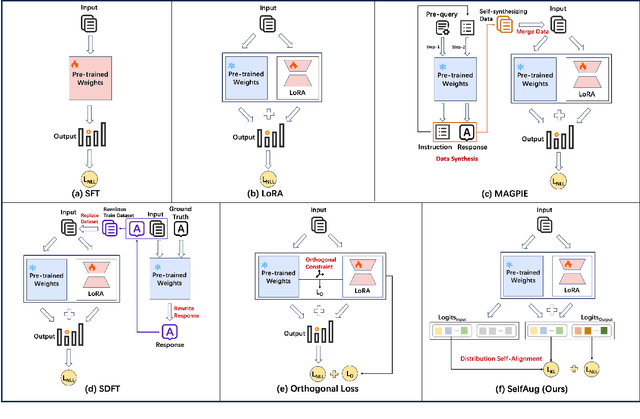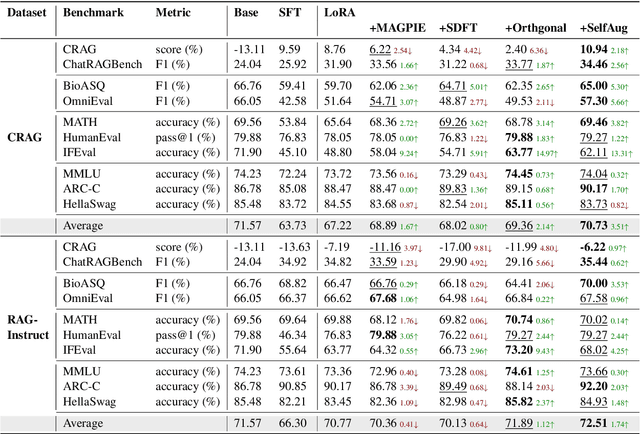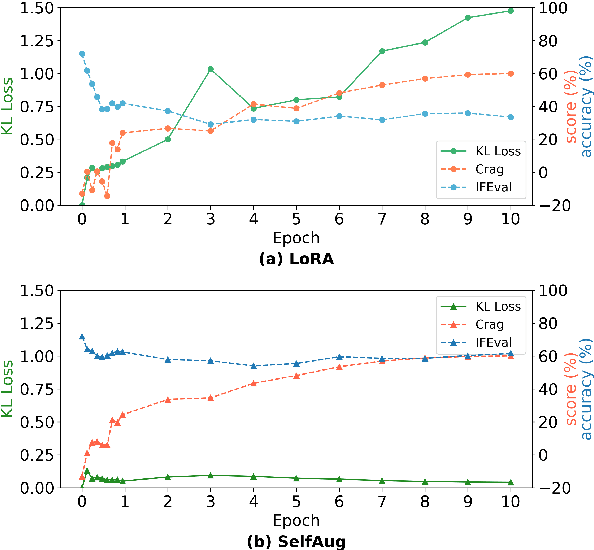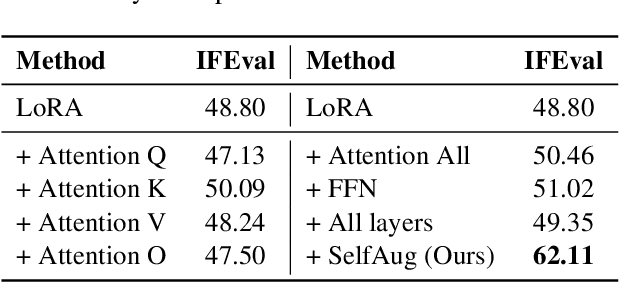Enhong Chen
From Feature Interaction to Feature Generation: A Generative Paradigm of CTR Prediction Models
Dec 16, 2025



Abstract:Click-Through Rate (CTR) prediction, a core task in recommendation systems, aims to estimate the probability of users clicking on items. Existing models predominantly follow a discriminative paradigm, which relies heavily on explicit interactions between raw ID embeddings. However, this paradigm inherently renders them susceptible to two critical issues: embedding dimensional collapse and information redundancy, stemming from the over-reliance on feature interactions \emph{over raw ID embeddings}. To address these limitations, we propose a novel \emph{Supervised Feature Generation (SFG)} framework, \emph{shifting the paradigm from discriminative ``feature interaction" to generative ``feature generation"}. Specifically, SFG comprises two key components: an \emph{Encoder} that constructs hidden embeddings for each feature, and a \emph{Decoder} tasked with regenerating the feature embeddings of all features from these hidden representations. Unlike existing generative approaches that adopt self-supervised losses, we introduce a supervised loss to utilize the supervised signal, \ie, click or not, in the CTR prediction task. This framework exhibits strong generalizability: it can be seamlessly integrated with most existing CTR models, reformulating them under the generative paradigm. Extensive experiments demonstrate that SFG consistently mitigates embedding collapse and reduces information redundancy, while yielding substantial performance gains across various datasets and base models. The code is available at https://github.com/USTC-StarTeam/GE4Rec.
Agent-R1: Training Powerful LLM Agents with End-to-End Reinforcement Learning
Nov 18, 2025Abstract:Large Language Models (LLMs) are increasingly being explored for building Agents capable of active environmental interaction (e.g., via tool use) to solve complex problems. Reinforcement Learning (RL) is considered a key technology with significant potential for training such Agents; however, the effective application of RL to LLM Agents is still in its nascent stages and faces considerable challenges. Currently, this emerging field lacks in-depth exploration into RL approaches specifically tailored for the LLM Agent context, alongside a scarcity of flexible and easily extensible training frameworks designed for this purpose. To help advance this area, this paper first revisits and clarifies Reinforcement Learning methodologies for LLM Agents by systematically extending the Markov Decision Process (MDP) framework to comprehensively define the key components of an LLM Agent. Secondly, we introduce Agent-R1, a modular, flexible, and user-friendly training framework for RL-based LLM Agents, designed for straightforward adaptation across diverse task scenarios and interactive environments. We conducted experiments on Multihop QA benchmark tasks, providing initial validation for the effectiveness of our proposed methods and framework.
Look As You Think: Unifying Reasoning and Visual Evidence Attribution for Verifiable Document RAG via Reinforcement Learning
Nov 15, 2025Abstract:Aiming to identify precise evidence sources from visual documents, visual evidence attribution for visual document retrieval-augmented generation (VD-RAG) ensures reliable and verifiable predictions from vision-language models (VLMs) in multimodal question answering. Most existing methods adopt end-to-end training to facilitate intuitive answer verification. However, they lack fine-grained supervision and progressive traceability throughout the reasoning process. In this paper, we introduce the Chain-of-Evidence (CoE) paradigm for VD-RAG. CoE unifies Chain-of-Thought (CoT) reasoning and visual evidence attribution by grounding reference elements in reasoning steps to specific regions with bounding boxes and page indexes. To enable VLMs to generate such evidence-grounded reasoning, we propose Look As You Think (LAT), a reinforcement learning framework that trains models to produce verifiable reasoning paths with consistent attribution. During training, LAT evaluates the attribution consistency of each evidence region and provides rewards only when the CoE trajectory yields correct answers, encouraging process-level self-verification. Experiments on vanilla Qwen2.5-VL-7B-Instruct with Paper- and Wiki-VISA benchmarks show that LAT consistently improves the vanilla model in both single- and multi-image settings, yielding average gains of 8.23% in soft exact match (EM) and 47.0% in IoU@0.5. Meanwhile, LAT not only outperforms the supervised fine-tuning baseline, which is trained to directly produce answers with attribution, but also exhibits stronger generalization across domains.
LIHE: Linguistic Instance-Split Hyperbolic-Euclidean Framework for Generalized Weakly-Supervised Referring Expression Comprehension
Nov 15, 2025



Abstract:Existing Weakly-Supervised Referring Expression Comprehension (WREC) methods, while effective, are fundamentally limited by a one-to-one mapping assumption, hindering their ability to handle expressions corresponding to zero or multiple targets in realistic scenarios. To bridge this gap, we introduce the Weakly-Supervised Generalized Referring Expression Comprehension task (WGREC), a more practical paradigm that handles expressions with variable numbers of referents. However, extending WREC to WGREC presents two fundamental challenges: supervisory signal ambiguity, where weak image-level supervision is insufficient for training a model to infer the correct number and identity of referents, and semantic representation collapse, where standard Euclidean similarity forces hierarchically-related concepts into non-discriminative clusters, blurring categorical boundaries. To tackle these challenges, we propose a novel WGREC framework named Linguistic Instance-Split Hyperbolic-Euclidean (LIHE), which operates in two stages. The first stage, Referential Decoupling, predicts the number of target objects and decomposes the complex expression into simpler sub-expressions. The second stage, Referent Grounding, then localizes these sub-expressions using HEMix, our innovative hybrid similarity module that synergistically combines the precise alignment capabilities of Euclidean proximity with the hierarchical modeling strengths of hyperbolic geometry. This hybrid approach effectively prevents semantic collapse while preserving fine-grained distinctions between related concepts. Extensive experiments demonstrate LIHE establishes the first effective weakly supervised WGREC baseline on gRefCOCO and Ref-ZOM, while HEMix achieves consistent improvements on standard REC benchmarks, improving IoU@0.5 by up to 2.5\%. The code is available at https://anonymous.4open.science/r/LIHE.
TeaRAG: A Token-Efficient Agentic Retrieval-Augmented Generation Framework
Nov 07, 2025Abstract:Retrieval-Augmented Generation (RAG) utilizes external knowledge to augment Large Language Models' (LLMs) reliability. For flexibility, agentic RAG employs autonomous, multi-round retrieval and reasoning to resolve queries. Although recent agentic RAG has improved via reinforcement learning, they often incur substantial token overhead from search and reasoning processes. This trade-off prioritizes accuracy over efficiency. To address this issue, this work proposes TeaRAG, a token-efficient agentic RAG framework capable of compressing both retrieval content and reasoning steps. 1) First, the retrieved content is compressed by augmenting chunk-based semantic retrieval with a graph retrieval using concise triplets. A knowledge association graph is then built from semantic similarity and co-occurrence. Finally, Personalized PageRank is leveraged to highlight key knowledge within this graph, reducing the number of tokens per retrieval. 2) Besides, to reduce reasoning steps, Iterative Process-aware Direct Preference Optimization (IP-DPO) is proposed. Specifically, our reward function evaluates the knowledge sufficiency by a knowledge matching mechanism, while penalizing excessive reasoning steps. This design can produce high-quality preference-pair datasets, supporting iterative DPO to improve reasoning conciseness. Across six datasets, TeaRAG improves the average Exact Match by 4% and 2% while reducing output tokens by 61% and 59% on Llama3-8B-Instruct and Qwen2.5-14B-Instruct, respectively. Code is available at https://github.com/Applied-Machine-Learning-Lab/TeaRAG.
A Survey on Deep Text Hashing: Efficient Semantic Text Retrieval with Binary Representation
Oct 31, 2025



Abstract:With the rapid growth of textual content on the Internet, efficient large-scale semantic text retrieval has garnered increasing attention from both academia and industry. Text hashing, which projects original texts into compact binary hash codes, is a crucial method for this task. By using binary codes, the semantic similarity computation for text pairs is significantly accelerated via fast Hamming distance calculations, and storage costs are greatly reduced. With the advancement of deep learning, deep text hashing has demonstrated significant advantages over traditional, data-independent hashing techniques. By leveraging deep neural networks, these methods can learn compact and semantically rich binary representations directly from data, overcoming the performance limitations of earlier approaches. This survey investigates current deep text hashing methods by categorizing them based on their core components: semantic extraction, hash code quality preservation, and other key technologies. We then present a detailed evaluation schema with results on several popular datasets, followed by a discussion of practical applications and open-source tools for implementation. Finally, we conclude by discussing key challenges and future research directions, including the integration of deep text hashing with large language models to further advance the field. The project for this survey can be accessed at https://github.com/hly1998/DeepTextHashing.
A2R: An Asymmetric Two-Stage Reasoning Framework for Parallel Reasoning
Sep 26, 2025



Abstract:Recent Large Reasoning Models have achieved significant improvements in complex task-solving capabilities by allocating more computation at the inference stage with a "thinking longer" paradigm. Even as the foundational reasoning capabilities of models advance rapidly, the persistent gap between a model's performance in a single attempt and its latent potential, often revealed only across multiple solution paths, starkly highlights the disparity between its realized and inherent capabilities. To address this, we present A2R, an Asymmetric Two-Stage Reasoning framework designed to explicitly bridge the gap between a model's potential and its actual performance. In this framework, an "explorer" model first generates potential solutions in parallel through repeated sampling. Subsequently,a "synthesizer" model integrates these references for a more refined, second stage of reasoning. This two-stage process allows computation to be scaled orthogonally to existing sequential methods. Our work makes two key innovations: First, we present A2R as a plug-and-play parallel reasoning framework that explicitly enhances a model's capabilities on complex questions. For example, using our framework, the Qwen3-8B-distill model achieves a 75% performance improvement compared to its self-consistency baseline. Second, through a systematic analysis of the explorer and synthesizer roles, we identify an effective asymmetric scaling paradigm. This insight leads to A2R-Efficient, a "small-to-big" variant that combines a Qwen3-4B explorer with a Qwen3-8B synthesizer. This configuration surpasses the average performance of a monolithic Qwen3-32B model at a nearly 30% lower cost. Collectively, these results show that A2R is not only a performance-boosting framework but also an efficient and practical solution for real-world applications.
LLM Cache Bandit Revisited: Addressing Query Heterogeneity for Cost-Effective LLM Inference
Sep 19, 2025Abstract:This paper revisits the LLM cache bandit problem, with a special focus on addressing the query heterogeneity for cost-effective LLM inference. Previous works often assume uniform query sizes. Heterogeneous query sizes introduce a combinatorial structure for cache selection, making the cache replacement process more computationally and statistically challenging. We treat optimal cache selection as a knapsack problem and employ an accumulation-based strategy to effectively balance computational overhead and cache updates. In theoretical analysis, we prove that the regret of our algorithm achieves an $O(\sqrt{MNT})$ bound, improving the coefficient of $\sqrt{MN}$ compared to the $O(MN\sqrt{T})$ result in Berkeley, where $N$ is the total number of queries and $M$ is the cache size. Additionally, we also provide a problem-dependent bound, which was absent in previous works. The experiment rely on real-world data show that our algorithm reduces the total cost by approximately 12\%.
Composable Score-based Graph Diffusion Model for Multi-Conditional Molecular Generation
Sep 11, 2025Abstract:Controllable molecular graph generation is essential for material and drug discovery, where generated molecules must satisfy diverse property constraints. While recent advances in graph diffusion models have improved generation quality, their effectiveness in multi-conditional settings remains limited due to reliance on joint conditioning or continuous relaxations that compromise fidelity. To address these limitations, we propose Composable Score-based Graph Diffusion model (CSGD), the first model that extends score matching to discrete graphs via concrete scores, enabling flexible and principled manipulation of conditional guidance. Building on this foundation, we introduce two score-based techniques: Composable Guidance (CoG), which allows fine-grained control over arbitrary subsets of conditions during sampling, and Probability Calibration (PC), which adjusts estimated transition probabilities to mitigate train-test mismatches. Empirical results on four molecular datasets show that CSGD achieves state-of-the-art performance, with a 15.3% average improvement in controllability over prior methods, while maintaining high validity and distributional fidelity. Our findings highlight the practical advantages of score-based modeling for discrete graph generation and its capacity for flexible, multi-property molecular design.
SelfAug: Mitigating Catastrophic Forgetting in Retrieval-Augmented Generation via Distribution Self-Alignment
Sep 04, 2025



Abstract:Recent advancements in large language models (LLMs) have revolutionized natural language processing through their remarkable capabilities in understanding and executing diverse tasks. While supervised fine-tuning, particularly in Retrieval-Augmented Generation (RAG) scenarios, effectively enhances task-specific performance, it often leads to catastrophic forgetting, where models lose their previously acquired knowledge and general capabilities. Existing solutions either require access to general instruction data or face limitations in preserving the model's original distribution. To overcome these limitations, we propose SelfAug, a self-distribution alignment method that aligns input sequence logits to preserve the model's semantic distribution, thereby mitigating catastrophic forgetting and improving downstream performance. Extensive experiments demonstrate that SelfAug achieves a superior balance between downstream learning and general capability retention. Our comprehensive empirical analysis reveals a direct correlation between distribution shifts and the severity of catastrophic forgetting in RAG scenarios, highlighting how the absence of RAG capabilities in general instruction tuning leads to significant distribution shifts during fine-tuning. Our findings not only advance the understanding of catastrophic forgetting in RAG contexts but also provide a practical solution applicable across diverse fine-tuning scenarios. Our code is publicly available at https://github.com/USTC-StarTeam/SelfAug.
 Add to Chrome
Add to Chrome Add to Firefox
Add to Firefox Add to Edge
Add to Edge